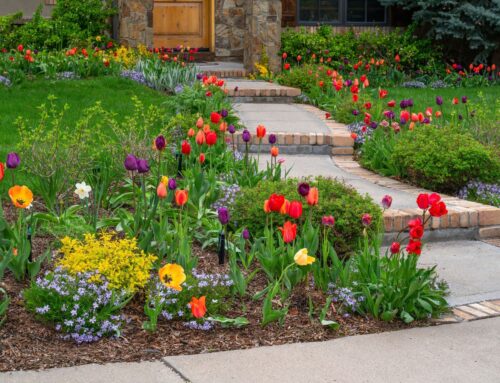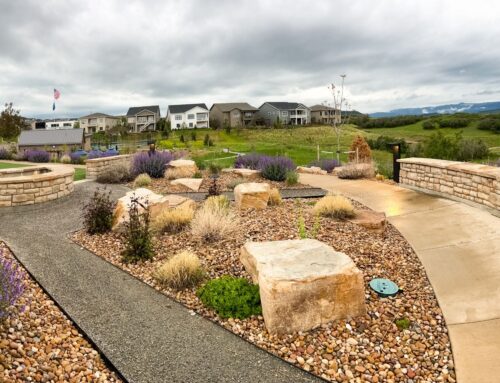Why Fall is the Best Time to Plan Your Spring Landscape Renovation
Planning a spring landscape renovation in the fall gives homeowners a clear advantage. The cooler weather and steady moisture help new plants, trees, and shrubs establish strong roots before winter. Fall is the perfect time for a landscaping project, as it allows better preparation and a smoother start to spring projects because the ground is ideal for planting, and contractors are more available.
By starting early, it’s easier to avoid the spring rush that can cause delays and rushed decisions. Fall planning also gives time to finalize landscaping design, purchase materials ahead of time, and tackle small tasks that build toward the final goal. This approach reduces stress and increases the chances of a successful, beautiful spring landscape renovation.
Why Fall is the Best Time to Plan Your Spring Landscape Renovation
Advantages of Planning Spring Landscape Renovation in Fall
Planning a spring landscape renovation in the fall gives homeowners a head start on design, contractor availability, plant selection, and cost management. This fall landscape preparation allows for well-thought-out decisions and smoother execution when spring arrives.
Optimal Time for Design and Conceptualization
Fall offers a slower pace, allowing homeowners and designers to carefully develop garden beds and layout ideas without pressure. Cooler temperatures and less yard activity provide space to study the property’s needs and preferences.
During this time, people can assess sun exposure, soil conditions, and slopes more clearly. It is easier to revise layouts and incorporate new ideas because changes are made ahead of the busy spring season. This thoughtful planning truly sets the stage for stronger results in spring.
Availability of Landscaping Professionals
Fall is generally less busy for landscapers compared to spring. Many homeowners start projects in spring when demand peaks, so contractors are often booked weeks or months in advance.
By planning in the fall, it is easier to find and secure reputable landscaping professionals. This reduces stress and ensures more flexibility for your spring landscape renovation.
Strategic Plant and Material Selection
Fall planning gives gardeners time to research and select trees, shrubs, and perennials best suited for spring planting. Homeowners can also order materials like mulch, compost, or decorative stone in advance.
Careful selection supports healthier plant growth and long-term landscape success. Preparing early also allows you to improve the soil with organic matter, ensuring the ground is ready for planting in spring.
Cost Savings and Incentives
Planning a spring landscape renovation in the fall often leads to financial benefits. Some suppliers and contractors offer discounts or lower rates during the off-peak fall season.
Early booking can avoid premium costs linked to the spring rush. It also allows homeowners time to budget and spread payments over several months instead of facing spring expenses all at once.
Additionally, careful planning prevents last-minute purchases or expensive changes, which add to the total cost. Fall gives time to shop around and compare prices, making the renovation more affordable and efficient.
Preparing Your Property for Spring
Preparing a property for spring involves careful evaluation and improvement. Key steps include checking the site for issues, testing and enhancing soil quality, and maintaining landscape infrastructure.
Conducting a Site Assessment
A thorough site assessment identifies problem areas and opportunities for improvement. The evaluation should include checking drainage patterns to prevent water pooling or erosion.
Inspect existing plants for health and spacing. Note any dead or overcrowded trees and shrubs that may need removal or trimming before spring growth.
Assess sun exposure and wind patterns to plan plant placement suited to environmental conditions. Document any areas with compacted soil or visible damage from pests.
Taking detailed notes and photos helps prioritize tasks and guide decisions during the renovation process.
Soil Testing and Improvement
Soil testing determines nutrient levels, pH balance, and texture, which influence plant health. Collect samples from multiple spots to get an accurate overall picture.
Use a soil test kit or send samples to a lab for analysis. Based on results, amend the soil with lime, sulfur, compost, or fertilizers to correct deficiencies.
Aeration helps relieve soil compaction, improving root growth and water absorption. Fall’s cooler temperatures and natural moisture make it ideal for these actions.
Adding organic matter supports beneficial microbes and increases soil fertility, preparing the ground for healthier plants in spring.
Addressing Infrastructure Needs
Before the planting season begins, it’s important to make sure your landscape’s foundational systems are in top shape. Tackling infrastructure updates in the fall saves time and stress when spring arrives.
-
Inspect and repair irrigation systems to fix leaks, blockages, or outdated parts that waste water.
-
Replace or restore damaged edging, pathways, and retaining walls to prevent accidents and keep your landscape visually appealing.
-
Test outdoor lighting and drainage systems to ensure they function properly after winter weather.
-
Plan and schedule any major upgrades early, leaving plenty of time for professional installation before spring projects begin.
Key Steps for Effective Fall Planning
Planning a spring landscape renovation in the fall requires clear goals, a solid timeline, and a smart approach to installation phases. These steps help organize the process and reduce delays when the warmer weather arrives.
Setting Clear Landscape Goals
Before starting any work, it is important to define specific goals for the landscape. This means deciding what features to include, such as flower beds, pathways, or seating areas. Knowing the desired style, whether modern, natural, or formal, helps guide plant and material choices.
Budget limits should be established early. This prevents overspending and helps prioritize areas that need the most attention. Goals should also consider maintenance needs to match the user’s time and skills.
Clear goals ensure every step supports a unified vision. It also makes communicating with contractors easier and avoids common misunderstandings.
Creating a Detailed Project Timeline
An organized timeline is key to keeping your landscaping project efficient and stress-free. Planning each phase allows for smoother progress and ensures your healthy landscape comes together on schedule.
-
Break the renovation into manageable stages, specifying when to order materials, start construction, and set key planting dates.
-
Plan for weather patterns: schedule groundwork in early fall and plant hardy species in late fall for optimal establishment.
-
Set firm deadlines and checkpoints to monitor progress, keep contractors accountable, and quickly address any unexpected delays.
-
Allow enough time for contractor scheduling, preventing last-minute rushes, and ensuring quality workmanship.
Prioritizing Installation Phases
Effective fall planning breaks the renovation into phases based on priority. Structural tasks like grading, building paths, or installing irrigation come first. These create a foundation for planting and cosmetic features later.
Plants that root better in cooler weather should be installed in the fall, while others can wait until spring. This prioritization protects less hardy plants and spreads out the work to avoid overwhelm.
Rank each phase by how much it impacts your final look and what’s doable in fall conditions. This way, you use your time and resources wisely and keep your landscape maintenance manageable.
Long-Term Benefits of Early Landscape Planning
Planning a landscape renovation early sets the stage for healthier plants, higher property value, and better environmental impact. Taking these steps in the fall allows for careful preparation and smart choices that pay off in spring and beyond.
Enhanced Plant Establishment
Starting landscape planning in the fall gives plants more time to develop strong roots before the growing season. Cooler temperatures and consistent soil moisture help trees, shrubs, and perennials settle in without stress.
Plants planted too late or in spring often focus on survival rather than growth. By planting or preparing in the fall, they conserve energy to build roots underground. This leads to healthier, more resilient plants that handle heat and drought better later.
Strong roots started in the fall also help prevent soil erosion and boost nutrient uptake. This early start results in a healthy landscape that needs less intervention and bounces back faster after rough weather.
Increased Property Value
A well-planned landscape adds value to a property by improving curb appeal and outdoor space usability. Starting planning in the fall means the project can be ready or underway come spring, which increases the home’s attractiveness during peak selling seasons.
Investing time early helps avoid delays from bad weather or contractor scheduling conflicts in the spring. Homeowners who plan often save money and get better quality work.
Good landscaping creates inviting spaces, boosts vibrant color, and increases the home’s appraised value with new beds, walkways, or outdoor living areas.
Environmental and Sustainability Advantages
Planning in the fall supports sustainable gardening by allowing better soil preparation and mulching. This reduces the need for chemical fertilizers and excessive watering during spring and summer.
Fall planning also encourages choosing native or drought-resistant plants, which thrive with less maintenance. This approach conserves water, lowers energy use for irrigation, and supports local wildlife.
Additionally, starting early simplifies composting and organic waste management, improving soil health naturally. The timing helps reduce erosion and runoff, protecting nearby water sources. Planning with sustainability in mind means a landscape that benefits both the homeowner and the environment over many years.
Avoiding Common Landscape Renovation Pitfalls
Effective landscape renovation requires attention to soil and weather challenges early in the process. Fixing drainage problems and getting ready for tough winter weather can help avoid delays or damage to spring planting. Proper planning protects the investment and ensures a smoother renovation.
Addressing Drainage and Erosion Early
Poor drainage can cause water to pool, resulting in root rot and soil erosion. It is important to identify low spots where water collects and install proper drainage solutions, like French drains or swales, before planting. Improving soil structure with organic matter also helps water absorb evenly.
Slopes need extra care to prevent erosion. Using erosion control blankets or planting ground covers stabilizes the soil. Early intervention reduces the risk of costly repairs later and supports healthy plant growth once spring comes.
Mitigating Late Winter Weather Risks
Late winter freezes and thaw cycles can harm new plants and disturb soil structure. Mulching around shrubs and trees protects roots from temperature swings and moisture loss. Choosing hardy plant varieties suited to the local climate reduces susceptibility to winter damage.
Avoid heavy foot traffic on renovated areas during thaw periods. Compacted soil slows root growth and water absorption. Marking off vulnerable spots with stakes or temporary fencing helps protect the landscape during critical early stages.
SOLMAUNA Creations & Landscaping Designs in Colorado
Our team of landscape designers brings a unique combination of landscape architecture education paired with extensive knowledge of plants to the table. Contact us today.






